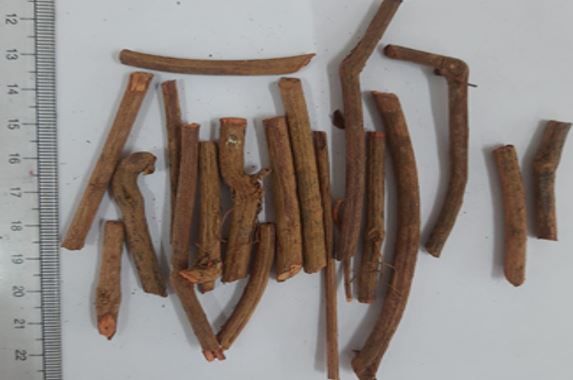Comparative physicochemical study of Manjishta Kwatha prepared by using different proportion of water
DOI:
https://doi.org/10.21760/jaims.9.9.7Keywords:
Manjishta Kwatha, Rubia cordifolia, pH value, specific gravity, fuel, time, parametersAbstract
Introduction: Due to ambiguity in literature regarding Kwatha preparation, exact proportion of water needed as per consistency of Dravya (Drug) for optimum quality of Kwatha is the need for standard pharmaceutical practices. For this purpose Manjishta was selected for Kwatha preparation using two different proportion of water. Aim and Objectives: To find out the difference in physicochemical parameters to access the quality of Manjishta Kwatha in order to save time and fuel required for Kwatha with the objective to prepare Manjishta Kwatha by using two different proportion of water and to compare time and fuel needed. Methods: Procurement and Authentication of Manjishta were done as per standard protocol. Manjishta Kwatha were prepared by using two different proportion of water one by using 16 parts of water and second by using 8 parts of water by reduced 1/8th and 1/4th respectively. In process and finished products observations were noted as per procedure. Analytical testing was done as per Ayurved Pharmacopeia of India. Observations and Results: In physicochemical analysis, the pH value, refractive index and specific gravity have not shown any remarkable difference however total solid content were found to be more in the Kwatha which used eight parts of water. The fuel and time consumed were three times more in the sample which used sixteen parts of water. So, Manjishta can be considered as Madhyam (Medium) consistency drug for Kwatha purpose. This study provided the preliminary physicochemical parameters for the Manjishta Kwatha. Further it needs to study qualitative parameters with highly sophisticated analytical techniques.
Downloads
References
Sharangadhara, Sharangadhara Samhita, Md. Kh. 2/1 - 2, Commentary by Dr.Brahmanand Tripathi, Chaukhamba Surbharti Prakshana, Varanasi; 2010. P.133-134.Chapter nine 2, 3, 4,: 218- 219,
Sushruta.Sushruta Samhita. Chi. Sth. 31/8. Chaukhambha Sanskrit Sansthan Varanasi; 2005. 134
Sharangadhara, Sharangadhara Samhita, Commentary by Dr. Shailaja Shrivastava, Chapter 9, verse 3, Choukhambha Orientalia, Varanasi, Fourth Edition: 2005, : 215
Anonymous, The Ayurvedic pharmacopoeia of India, part- i, volume – iii, Government of India ministry of health and family welfare department of ISM & H, page 112-114
Ashish Verma, Hetal Janani, Shobhnath Yadav, Galib, PK prajapati, Pharmaceutical and Analytical Studies of Guduchi Kwatha Prepared by varying Proportion of Water, Journal of Ayurvedic and Herbal Medicine 2016:2(4):125 -130
Anonymous, The Ayurvedic Pharmacopoeia of India (API), Part-I, Vol.-IX (Extracts);(Appendix – 2.1.11), First Edition, Government of India, Ministry of Ayush, Published by Pharmacopoeia Commission for Indian Medicine & Homoeopathy, Ghaziabad; 2016, p114 -115.
Anonymous, The Ayurvedic Pharmacopoeia of India, Part – I, Volume – VI, (3.1. Physical tests and Determinations, Appendix – 3, First Edition, Government of India, Ministry of Ayush, Published by Pharmacopoeia Commission for Indian Medicine & Homoeopathy, Ghaziabad; 2008, p 324-25.
Anonymous, The Ayurvedic Pharmacopoeia of India, Part – I, Volume – VI, (3.1. Physical tests and Determinations, Appendix – 3, First Edition, Government of India, Ministry of Ayush, Published by Pharmacopoeia Commission for Indian Medicine &Homoeopathy, Ghaziabad; 2008, p 324.
Anonymous, The Ayurvedic Pharmacopoeia of India (API), Part-I, Vol.-IX (Extracts);(Appendix – 2.1.11), First Edition, Government of India, Ministry of Ayush, Published by Pharmacopoeia Commission for Indian Medicine &Homoeopathy, Ghaziabad; 2016. p115
Meena et al, Kwatha Kalpana: It’s Versatility and probable Advancement, Asian Journal of Pharmaceutics, Oct –Dec 2017(Suppl) 11(4): p678 684
Apeksha A. Patil, Dhiraj B. Patil. Comparative Pharmaceutico-Analytical Study of Mustakadi Pramathya and Mustakadi Kwatha. J Ayurveda Integr Med Sci 2017; 1:p114-116. http://dx.doi.org/10.21760/jaims.v2i1.7497















